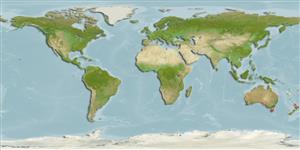>
Gobiiformes (Gobies) >
Gobiidae (Gobies) > Gobiinae
Etymology: Arenigobius: Latin, arena, harena, -ae = sand + Greek, kobios or Latin gobius = gudgeon (Ref. 45335).
More on author: Kner.
Environment: milieu / climate zone / depth range / distribution range
Ecología
marino; salobre demersal; rango de profundidad 0 - 1 m (Ref. 45534). Subtropical
Indo-West Pacific: endemic to southern Australia.
Tamaño / Peso / Age
Maturity: Lm ? range ? - ? cm
Max length : 7.6 cm SL macho / no sexado; (Ref. 45534); 9.1 cm SL (female)
Espinas dorsales (total): 7; Radios blandos dorsales (total): 10-11; Espinas anales 1; Radios blandos anales: 10. Distinguished by the following characters: body colour light brown; two oblique dark bands originating on head below eye, the upper degenerating into diffuse purplish brown blotches from the pectoral to caudal peduncle; black stripe arising at the pectoral insertion and running along lower body before breaking into small black spots above anal fin; dorsal fins with a horizontal dark band near the base; dark blue mark on membrane distally between first and second rays of D2; iridescent irregular blue blotches along flanks; three or more approximately vertical bands on upper caudal; vertebrae 10+15 (vertebral counts taken from radiograph); body cylindrical; snout blunt; eyes large, and close together dorsally; origin of pectorals under posterior margin of operculum; caudal oval and elongate; 7th pectoral ray extended into a filament; pelvics united into cup-shaped disc with branched rays; origin of pelvics covered by a loose sheath of skin; scales cycloid on belly and dorsally to second dorsal origin; posterior lateral scales peripheral ctenoid; head and predorsal region naked (Ref. 45534).
Facultative air-breathing (Ref. 126274); Found in muddy coastal areas to upper estuaries, rocky reefs, in sea grass beds and mangroves (Ref. 9002).
Life cycle and mating behavior
Madurez | Reproducción | Puesta | Huevos | Fecundidad | Larva
Gomon, M.F., C.J.M. Glover and R.H. Kuiter (eds.), 1994. The fishes of Australia's south coast. State Print, Adelaide. 992 p. (Ref. 33839)
IUCN Red List Status (Ref. 130435)
Threat to humans
Harmless
Human uses
Más información
Nombres comunesSinónimosMetabolismoDespredadoresEcotoxicologíaReproducciónMadurezPuestaAgregación para la puestaFecundidadHuevosEgg development
ReferenciasAcuiculturaPerfil de acuiculturaRazasGenéticaElectrophoresesheritabilidadEnfermedadesProcesamientoNutrientsMass conversion
ColaboradoresImágenesStamps, Coins Misc.SonidosCiguateraVelocidadTipo de nataciónSuperficie branquialOtolitosCerebrosVisión
Herramientas
Special reports
Download XML
Fuentes de Internet
Estimates based on models
Preferred temperature (Ref.
123201): 14.6 - 24.9, mean 17.9 °C (based on 272 cells).
Phylogenetic diversity index (Ref.
82804): PD
50 = 0.6250 [Uniqueness, from 0.5 = low to 2.0 = high].
Bayesian length-weight: a=0.00708 (0.00333 - 0.01504), b=3.09 (2.92 - 3.26), in cm total length, based on LWR estimates for this (Sub)family-body shape (Ref.
93245).
Nivel trófico (Ref.
69278): 3.3 ±0.4 se; based on size and trophs of closest relatives
Resiliencia (Ref.
120179): Alto, población duplicada en un tiempo mínimo inferior a 15 meses (Preliminary K or Fecundity.).
Fishing Vulnerability (Ref.
59153): Low vulnerability (10 of 100).
